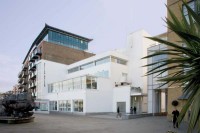The Design Museum is the world’s leading museum devoted to architecture to industrial design. Terence Conran established the forerunner of the Design Museum, the Boilerhouse, in the basement of the Victoria and Albert Museum (V&A) in London. The Boilerhouse quickly outgrew the V&A, and in 1989 it moved on to become the Design Museum, in an architecturally striking transformation of a Thames side warehouse near Tower Bridge. Since then it has emerged as an institution with international status and significance, playing a vital role in making design and architecture a part of the cultural agenda. The museum remains an independent registered charity, run as a charity governed by a board of trustees.
The Challenge
The Design Museum already uses Ipsos Retail Performance’s footfall counting solution, but was interested in looking at the flow of visitors into a new Sir Terence Conran exhibition entitled ‘How We Live Today’.
The Design Museum wanted to understand specifically how long customers spent in the exhibit and where they spent their time. The museum also wanted to check which way traffic flowed around the museum, what age group were visiting the exhibit and what the dwell times on particular sections of the exhibition were, so they could learn from this for future exhibits.
The Solution
Ipsos Retail Performance used its Shopper Engage Lite solution to provide the Design Museum with quantitative feedback on performance and customer experience. No installation of electronic equipment was required. Instead, customer movements and interactions were recorded by discreet observers using maps and digital pens, which were then analysed to provide invaluable insights. A debrief with detailed information was then delivered to the Design Museum via a series of management reports.
What Ipsos Retail Performance did
Ipsos Retail Performance spent two consecutive days in the museum observing visitor behaviour. The observations were captured at all times of the day and were objective and uncompromised. The reporting team then analysed the data and provided full reporting back to the Design Museum, helping them to understand where they could make simple changes to exhibits and providing them with additional research material to share with future sponsors.
Analysis was broken down and explained to the Design Museum focusing on a number of key areas. These included looking at ‘Hot Spots’ in the exhibit with a consequent heat map that showed the frequency of stop and look activity and dwell time by zone and by gender. Also highlighted was navigation around the exhibit with a specific focus on first ‘stop and look’ destinations. Specific facts were highlighted such as men and women navigated around the exhibit in slightly different ways. Men were happy to wander around each zone with no set path, whereas the women liked to stay to a strict flow around the exhibit. By checking the navigation paths around the exhibit, the analysis also highlighted the need for more detailed signage at the start of the exhibition.
The Outcome
 Harry Asmah, Assistant Operations Manager at the Design Museum, said: “The Design Museum is all about contemporary, innovative design and working with Ipsos Retail Performance on this research, using the latest consumer behavioural analysis is exciting for us, as it fits perfectly with our mission and gives us a greater understanding of visitor behaviour. The detailed feedback we have received has been beneficial in a number of ways for this show and highlighted specific areas that we can learn from when creating future exhibits.”
Harry Asmah, Assistant Operations Manager at the Design Museum, said: “The Design Museum is all about contemporary, innovative design and working with Ipsos Retail Performance on this research, using the latest consumer behavioural analysis is exciting for us, as it fits perfectly with our mission and gives us a greater understanding of visitor behaviour. The detailed feedback we have received has been beneficial in a number of ways for this show and highlighted specific areas that we can learn from when creating future exhibits.”
Ipsos Retail Performance
UK office: +44 (0) 1908 682 700





Comments are closed.